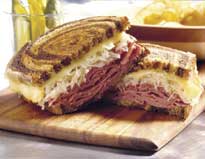Almost every person in the U.S.A. has eaten a sandwich in their day to day lives. whether it be at work during a lunch break, or at a fancy cafe for breakfast it is an important part of a persons day and the over all society of the United States. Sandwiches provide a well rounded meal that keeps you going, it’s easy to make and pack for work and they are affordable. A well-built sandwich can even be the highlight of a person’s day, improving moral at work and at home. However, what most people don’t think about as they take a large bite out of this common yet important part of the day is its history and origin.
As with a lot of things in America, the history of the sandwich did not start here, but in Europe. The earliest record of a form of sandwich is in Jewish history during the last century of the B.C.E. era in which Hillel The Elder, a famous Jewish religious leader, placed meat from the Paschal lamb and bitter herbs between two pieces of matzah bread during Passover. During the Middle Ages in Europe a meal was commonly set atop thick slabs of stale bread called trenchers which took the place of a plate, setting the stage for the open faced sandwich. The immediate precursor to the modern day sandwich was found in the Netherlands during the 17th century where a British naturalist observed in taverns that beef hung from the rafters and was cut into thin slices and place with butter between two pieces of bread. When the sandwich finally made it to the U.S.A. it was served as an upper class super, or late night snack. The history of the word “sandwich” originates in 18th century England with John Montagu, 4th Earl of Sandwich. It was said that he ordered his meals in between two pieces of bread to keep his hands clean enough to let him play cards while eating, so when people wanted the same they ordered “the same thing as Sandwich.” From this long history the sandwich has developed a distinct structure which has provided a template for many different types of sandwiches.
The distinct structure that makes a sandwich a sandwich is the placing of anything in between two of the same thing. This definition means that Oreos, burgers and some pastries are a form of sandwich. Through these guide lines many types of sandwiches have been created and introduced to the world.
Types of sandwiches stem from different cultures and with the United States’s history of immigration it has become the sandwich central of the world. In America you can find any type of sandwich. One of the greatest things to come from the huge mixing pot called the U.S.A. is the Hamburger which is usually composed of a ground beef patty stuck in between two sesame seed buns along with cheese, pickles, lettuce, onions, tomatoes, ketchup, and mayonnaise. This classic American food is now found all over the world, finding its place in the hearts of all mankind.
Some of the most common types of sandwiches are the PB&J, the grilled cheese, the Sub, the Club House sandwich, the sloppy Joe, and the Panini. All other types of sandwich are either a variation of one of these, or a combination of many.

Two of my personal favorites are the Reuben sandwich and the Club House sandwich. The Reuben is a hot sandwich composed of layered pastrami with Swiss cheese and coleslaw which is then grilled between two pieces of pumpernickel bread. The Club House is basically a double-decker sandwich with bacon, lettuce and tomato on the top layer, and a type of meat on the bottom layer, most commonly turkey. Each layer is divided by a slice of toasted bread (the type of bread varies), totaling three slices.
I hope to have educated you on the history and structure of the sandwich and I encourage you to try other types that you’ve never heard of. So next time you go out to eat, or are in the kitchen wondering what to make I hope you order a new sandwich off the menu, or find a new recipe online. I also hope that this new knowledge will inspire you to be creative in the kitchen when dealing with two pieces of bread. Who knows, you might be the one too create the next popular sandwich that will be found all over the world in the next decade or so.


















